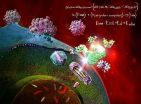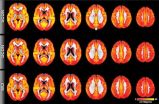Printing in the hobby room: Paper-thin and touch-sensitive displays on various materials
2014-10-07
(Press-News.org) Until now, if you want to print a greeting card for a loved one, you can use colorful graphics, fancy typefaces or special paper to enhance it. But what if you could integrate paper-thin displays into the cards, which could be printed at home and which would be able to depict self-created symbols or even react to touch? Those only some of the options computer scientists in Saarbrücken can offer.
They developed an approach that in the future will enable laypeople to print displays in any desired shape on various materials and therefore could change everyday life completely.
For example: A postcard depicts an antique car. If you press a button, the back axle and the steering wheel rim light up in the same color. Two segments on a flexible display, which have the same shape as those parts of the car, can realize this effect. Computer scientists working with Jürgen Steimle printed the post card using an off-the-shelf inkjet printer. It is electro-luminescent: If it is connected to electric voltage, it emits light. This effect is also used to light car dashboards at night.
Steimle is leader of the research group "Embodied Interaction" at the Cluster of Excellence "Multimodal Computing and Interaction". Simon Olberding is one of his researchers. "Until now, this was not possible", explains Olberding. "Displays were mass-produced, they were inflexible, they always had a rectangular shape." Olberding and Steimle want to change that. The process they developed works as follows: The user designs a digital template with programs like Microsoft Word or Powerpoint for the display he wants to create. By using the methods the computer scientists from Saarbrücken developed, called "Screen Printing" and "Conductive Inkjet Printing", the user can print those templates. Both approaches have strengths and weaknesses, but a single person can use them within either a few minutes or two to four hours. The printing results are relatively high-resolution displays with a thickness of only 0.1 millimeters. It costs around €20 to print on a DIN A4 page; the most expensive part is the special ink. Since the method can be used to print on materials like paper, synthetic material, leather, pottery, stone, metal and even wood, two-dimensional and even three-dimensional shapes can be realized. Their depiction can either consist of one segment (surface, shape, pattern, raster graphics), several segments or variously built-up matrixes. "We can even print touch-sensitive displays", says Olberding.
The possibilities for the user are various: displays can be integrated into almost every object in daily life – users can print not only on paper objects, but also on furniture or decorative accessories, bags or wearable items. For example, the strap of a wristwatch could be upgraded so that it lights up if a text message is received. "If we combine our approach with 3D printing, we can print three-dimensional objects that display information and are touch-sensitive", explains Steimle.
INFORMATION:
Background information about computer science research at Saarland University
The Department of Computer Science represents the center of computer science research in Saarbrücken, Germany. Seven other internationally renowned research institutes are nearby: The Max Planck Institutes for Informatics and for Software Systems, the German Research Center for Artificial Intelligence (DFKI), the Center for Bioinformatics, the Intel Visual Computing Institute, the Center for IT Security, Privacy and Accountability (CISPA), and the Cluster of Excellence "Multimodal Computing and Interaction".
Further information: http://embodied.mpi-inf.mpg.de/research/printscreen/
A press picture is available here: http://www.uni-saarland.de/pressefotos
A short video is available here: http://youtu.be/LiD7dnqY034
Press requests:
Dr. Jürgen Steimle
Cluster of Excellence "Multimodal Computing and Interaction"
Mail: jsteimle@mmci.uni-saarland.de
Phone: +49 681 302-71935
Simon Olberding
Cluster of Excellence "Multimodal Computing and Interaction"
Mail: solberding@mmci.uni-saarland.de
Phone: +49 681 302-71937
Editor:
Gordon Bolduan
Science Communication
Cluster of Excellence on "Multimodal Computing and Interaction"
Mail: bolduan@mmci.uni-saarland.de
Tel.: +49 (0)681/302-70741
[Attachments] See images for this press release:

ELSE PRESS RELEASES FROM THIS DATE:
2014-10-07
In a ground-breaking research project at the University of Gothenburg, seven Swedish women have had embryos reintroduced after receiving wombs from living donors. Now the first transplanted woman has delivered a baby – a healthy and normally developed boy. The world-unique birth was acknowledged in The Lancet on 5 October.
The uterus transplantation research project at the University of Gothenburg started in 1999 and has been evaluated in over 40 scientific articles. The goal of the Gothenburg project is to enable women who were born without a womb or who have lost ...
2014-10-07
To explore any possible limits of the two theories, they have been experimentally verified many times already and both have passed all the tests so far. Hence, scientists look for deviations in experiments with increasing precision or under extreme conditions.
For this purpose, Nörtershäuser's team has now accelerated ions to velocities near the speed of light and illuminated them with a laser.
The results, which are presented in two new publications, confirm the time dilation predicted for high velocities in the theory of relativity with an accuracy that ...
2014-10-07
Deerfield, Ill. (October 8, 2014) — The annual number of dengue fever cases in India is 282 times higher than officially reported, and the disease inflicts an economic burden on the country of at least US$1.11 billion each year in medical and other expenses, according to a new study published online today in the American Journal of Tropical Medicine & Hygiene.
The study, led by researchers at Brandeis University's Schneider Institute for Health Policy in Waltham, Massachusetts, the INCLEN Trust International in New Delhi, and the Indian Council of Medical Research's ...
2014-10-07
The battle against AIDS cannot be won in the laboratory alone. To fight the potentially deadly virus that 34 million people are suffering from we need help from computers. Now research fron University of Southern Denmark turns computers into powerful allies in the battle.
Effective treatment of HIV-virus is a race against time: Many of the drugs that have been potent killers of HIV-virus, have today lost their power, because the virus has become resistant to them. As a result science must constantly develop new drugs that can attack the virus in new ways.
Now researchers ...
2014-10-07
Scientists at The University of Texas Health Science Center at Houston (UTHealth), Monash University and RIKEN Centre for Developmental Biology have used a combination of small molecules to generate mouse cells that can form bone and cartilage. This new method is easily scalable, and hence is a promising approach for the repair of human bone and cartilage defects. The research has just been published at http://dev.biologists.org/ in the scientific journal Development.
Current strategies to regenerate bone and cartilage use adult stem cells that are committed to forming ...
2014-10-07
Boston, MA – The main function of the immune system is to protect against diseases and infections. For unknown reasons our immune system attacks healthy cells, tissues and organs in a process called autoimmunity, which can result in diseases such as multiple sclerosis, type 1 diabetes, lupus or rheumatoid arthritis. There are currently no existing cures for these diseases.
Now, in a new study by researchers at Brigham and Women's Hospital (BWH), a potential treatment maybe on the horizon. Researchers found that NAD+, a natural molecule found in living cells, plants ...
2014-10-07
Boston, MA — A new, large-scale study has identified six new genetic variants associated with habitual coffee drinking. The genome-wide meta-analysis, led by Harvard School of Public Health and Brigham and Women's Hospital researchers, helps explain why a given amount of coffee or caffeine has different effects on different people and provides a genetic basis for future research exploring the links between coffee and health.
"Coffee and caffeine have been linked to beneficial and adverse health effects. Our findings may allow us to identify subgroups of people most ...
2014-10-07
OAK BROOK, Ill. – A magnetic resonance imaging (MRI) technique can detect signs of cognitive decline in the brain even before symptoms appear, according to a new study published online in the journal Radiology. The technique has the potential to serve as a biomarker in very early diagnosis of preclinical dementia.
The World Health Organization estimates that dementia affects more than 35 million people worldwide, a number expected to more than double by 2030. Problems in the brain related to dementia, such as reduced blood flow, might be present for years but are ...
2014-10-07
A new model for stroke care is being studied in rural Alberta to reduce inequities in health across communities. This model, presented at the Canadian Stroke Congress, shows how hospitals in rural areas can mimic the type of care that's often only available in larger centres.
In geographically diverse Canada, stroke care can seem like tale of two cities – or more like a city and a small town. The ideal is stroke unit care, where a multidisciplinary staff of doctors, nurses and therapists collaborate on treatment and the road to recovery. In Alberta, that type of ...
2014-10-07
People who have had a stroke or transient ischemic attack (TIA or mini-stroke) are at high risk for a second similar event or other serious medical problems for at least five years and need better follow up and strategies to prevent these problems, according to data presented at the Canadian Stroke Congress.
At present, most stroke or TIA patients in Canada are followed closely by specialty clinics for about 90 days after an event, during the period they are considered at highest risk for a repeat event. If no such incident occurs during that period, they are often transferred ...
LAST 30 PRESS RELEASES:
[Press-News.org] Printing in the hobby room: Paper-thin and touch-sensitive displays on various materials



